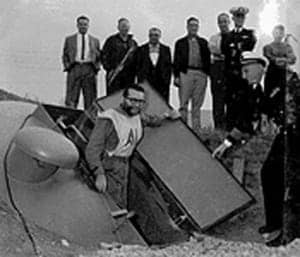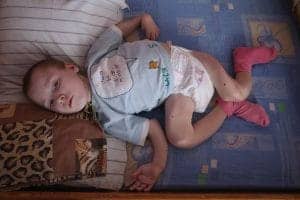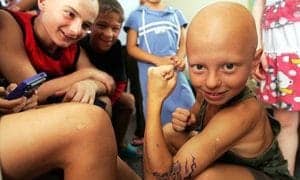by Janette D. Sherman, M.D.
Seventy years! As I was sorting through papers, correspondence, news clippings and records, I realized that nuclear bomb and nuclear power development occurred within my lifetime.

It was July 1945 when Trinity, the first atomic bomb, was detonated at the nuclear site in Alamogordo, New Mexico, followed the next month with a uranium bomb dropped on Hiroshima, and a hydrogen bomb on Nagasaki. At least 129,000 men, women and children were immediately killed, but that number does not include those who died thereafter from burns, radiation sickness, starvation and lack of medical care.
Just seven years later, in 1952, after graduating from college with a bachelor degree in biology and chemistry, I was hired by the Atomic Energy Commission (AEC, now NRC, Nuclear Regulatory Commission) as a radiological monitor at the “Rad Lab,” University of California in Berkeley. Even though I wrote human in the space for race, I passed a security clearance test, but why not? How much trouble can you get into when you are just 22 years old?
For the first two weeks after I was hired, I was assigned to read a stack of books on radiation physics. I had taken classes in biology and chemistry, but only a year of physics, and it did not include anything labeled nuclear. After I was hired, I carried Geiger and alpha counters and measured levels of radiation in laboratories, around the Cyclotron, in various buildings on the university campus and at a local hospital.
This era was early in the use of radioactive isotopes to measure biological processes. Professor Melvin Calvin, his laboratory glowing with light, won his Nobel Prize for his work on photosynthesis at the Rad Lab.
I remember monitoring a building where plutonium was refined. When plutonium decays and emits alpha particles, there is a “kickback”; thus, plutonium had crept out of the laboratories and spread contamination as far as to the building entrance.
It was July 1945 when Trinity, the first atomic bomb, was detonated at the nuclear site in Alamogordo, New Mexico, followed the next month with a uranium bomb dropped on Hiroshima, and a hydrogen bomb on Nagasaki. At least 129,000 men, women and children were immediately killed.
I don’t know if the building is still standing or if anyone found a way to contain the relentless creep of plutonium, a deadly element with a half-life of 25,000 years. We know that plutonium is released from bomb tests and nuclear power plants and that a single atom, ingested or inhaled, can radiate nearby living cells and initiate cancer and birth defects.
I had never heard of polycythemia vera (a red cell leukemia), but the Rad Lab attracted a number of patients who were treated with radioactive phosphorus (P-32) via the University-AEC program. On one occasion I accompanied Dr. Joseph Hamilton and his team to a hospital near the university where radioactive gold was injected into a woman’s abdomen to treat her ovarian cancer. My Geiger counter needle was off the scale as I was standing next to the doorway. I have no idea if these patients were healed or not.

Significant criticism of Dr. Hamilton’s and other experiments upon humans, using plutonium and other radioisotopes, is documented in Eileen Welsome’s book, “The Plutonium Files.” It is chilling reading, and I hope that passage of laws in the U.S. requiring informed consent has stopped such exposures. Unfortunately, those working on “cleaning up” Chernobyl and Fukushima and those living downstream from the bomb and nuclear power plant emissions have not been afforded such consent.
While working at the university “Rad Lab,” I was offered a research job at the U.S. Navy Radiological Defense Laboratory, located at Hunters Point in San Francisco. Hunters Point Naval Shipyard was the destination of ships that had been used in the Marshall Islands nuclear tests and contaminated by radioactive fallout.
It was grizzly work. We received some animals from the Nevada test site, but basically we studied the effects of radiation and thermal burns. We used a depilatory to remove the hair from rats, which were then given various levels of x-ray radiation, but the worst aspect was when they were anesthetized and then burned over various areas of their bodies, using a powerful searchlight.
The stench was awful, and the animals died in misery. That was in 1954, and there was no doubt in my mind, and certainly not in the minds of people with whom I worked, that an atomic bomb means painful and terrible suffering and death. Nuclear radioactivity cannot be seen, smelled or tasted, but the devastation is by enormous heat, light and sound.
It is that experience that stopped me from doing such animal research, with the exception of a job in the physiology department of Michigan State University (MSU) that required me to handle pigeons in an experiment using chlorpromazine (Thorazine) to induce a form of lactation in birds. The birds inevitably escaped my grasp and flew to the overhead pipes, whereupon I had to call one of the janitors to help catch them.
Significant criticism of Dr. Hamilton’s and other experiments upon humans, using plutonium and other radioisotopes, is documented in Eileen Welsome’s book, “The Plutonium Files.” It is chilling reading.
Oh yes, the finding was that the drug did cause lactation, and later, in the 1960s, I ran a diabetes clinic at Sinai Hospital in Detroit. The patients were largely refugees from Eastern Europe, and I saw many men with enlarged breasts who were given the drug. How many men and women have developed breast cancer from this drug, I have no idea.
As a chemist at MSU, I handled radioactive tracers to research metabolism in plants and in chickens. I did research to find a way to measure strontium and calcium in the presence of one another. The uptake of radioactive strontium (Sr-90) in place of calcium leads me to wonder if that research, done in the late 1950s, was pertinent to bomb testing.
Off and on, I worked for my family physician, when his nurse needed time off. He urged me to apply to medical school, so I took the medical school exam, the first time that I had taken an exam that was not an essay exam. I was certain that I had failed “directions.”

When I arrived for my interview at Wayne State University in Detroit and was asked where else had I applied, I answered, “No place.” When asked why, I said, “Because I wanted to go to Wayne.” The interviewer must have been stunned. I was naive and did not know that students applied to multiple schools. But given that I had two children, and their father had been interviewed for a job in Detroit, it was the only place I could go.
Radiation and its effects largely disappeared from my mind from 1960 to 1969 while I was in medical school and finishing my internship and residency training.
Except, in 1968 when I was hospitalized to investigate why I had developed significant loss of weight and tachycardia. After many tests, I was diagnosed with hyperthyroidism, and treated with radioactive I-131, which released a large amount of thyroid hormone and sent me into congestive heart failure.
Each time I went to the physician’s office, I noticed the waiting room was usually filled with patients. A year later, my mother, who had moved from upper New York State to Detroit, was also diagnosed with hyperthyroidism. This is not a familiar disease!
It was not until years later that I learned that Fermi, the nuclear power plant located near downtown Detroit, at the east end of Lake Erie, had been close to a meltdown. There was no discussion of a link at the time I was sick.
During that same period of time, the U.S. conducted nuclear bomb tests in Nevada, the Marshall Islands in the Pacific, and at still other sites. France, Britain, Russia, India and Pakistan also conducted bomb tests and built nuclear power plants.
Sometime in the 1980s, I was asked to review the case of two young boys, brothers who had developed bone cancer. They lived in proximity to the Fernald uranium processing plant, located about 20 miles northwest of Cincinnati, Ohio.
The AEC had opened the plant in 1948 to fabricate uranium fuel cores by chemical and metallurgical means. The plant was known as the Feed Materials Production Center since the uranium fuel cores it produced were the “feed” for the AEC’s plutonium production reactors, located in Oak Ridge, Tenn., Savannah River, S.C., and Hanford in Washington State.
Following the Chernobyl meltdown, there was an official governmental prohibition against diagnosing illnesses as having resulted from exposure to radioactivity, and three years more before health data were released. Since Fukushima, there has been a dearth of funds for research into the effects of the on-going radioactive releases worldwide, and barriers to publishing papers that look for associated effects.

Since the Chernobyl meltdown in 1986, we must thank those that observed, collected and published their findings. In 2008, Alexey Yablokov brought me a copy of “Chernobyl: The Consequences of the Catastrophe for People and the Environment,” in Russian, and said he needed an editor to put it into English, but he did not have any money to pay the person. I have written two books, and enjoy writing and editing, so I agreed to edit a translation into English. I did not realize that it would actually take me 14 months to edit the book.
The Chernobyl Catastrophe is a story of people – many of whom don’t know they are part of it. It includes essentially all who live in the Northern Hemisphere, the path of the radioactive fallout. Some people must be recognized for what they contributed under adverse environmental conditions, but also under adverse political conditions.
The senior author is Professor Yablokov who holds two doctoral degrees – one in biology for marine mammals and a second in science for population biology – and is the author of more than 400 scientific publications and 22 books. From 1992 to 1997, he was chairman of the Interagency Committee for Ecological Security for the National Security Council of the Russian Federation, then president of the Center for Russian Environmental Policy and deputy chairman of the Council of Ecological Problems of the Russian Academy of Science and vice president of the International Union of Conservation of Nature, as well as a consultant to Russian presidents Gorbachev and Yeltsin.
The second author is Vassily Nesterenko, who at the time of the Chernobyl catastrophe was director of the Nuclear Energy Institute at the Belarus Academy of Science. He requisitioned a helicopter and flew over the burning reactor, recording some of the few measurements available.
In 1990 he established BELRAD, the Institute of Radiation Safety, which was supported by Andrei Sakarov, the nuclear engineer and dissident, and Garry Karparov, the chess master. At BELRAD, Professor V. Nesterenko measured levels of cesium-137 and cesium-134 in some 340,000 food samples, and using whole-body counters, measured the radiation levels in the bodies of 290,000 children who lived in the most contaminated areas.
Following the Chernobyl meltdown, there was an official governmental prohibition against diagnosing illnesses as having resulted from exposure to radioactivity, and three years more before health data were released.
Professor Nesterenko devised a method to reduce radionuclide levels in children employing a food additive containing apple pectin. The usefulness of his research was demonstrated in double blind, placebo-controlled tests. He was the author of over 300 articles, despite failing health. Sadly he died shortly before the Chernobyl book was published in English.
The third author, Professor Alexey Nesterenko is the son of Vassily and continues to work at BELRAD, the Institute of Radiation Safety in Minsk, Belarus.

Some whose work appears in this book and who spoke out were in peril. These included Yuri Bandazhevsky, who at the time was professor of anatomy and director of the Medical Institute in Gomel, Belarus. Bandazhevsky determined Caesium-137 levels in children’s organs, examined at autopsy. The highest accumulation of Cs-137 was found in the endocrine glands, in particular in the thyroid, the adrenals and the pancreas. High levels were also found in the heart, the thymus and the spleen.
Bandazhevsky also measured radioactive cesium-137 in the food supply and recorded the same adverse findings in laboratory animals fed Cs-137. He criticized the government for not monitoring the food supply and protecting children.
He was arrested in 2001, allegedly for taking bribes from students and sentenced to eight years in prison. Efforts by his wife, pediatrician Galina Bandazhevskaya, who continued his work, resulted in his parole from prison on Aug. 5, 2005. He was prohibited from leaving Belarus for five months.
The mayor of Clermont-Ferrand, in France, invited him to work at the university and at the hospital on Chernobyl’s consequences. Since 1977, Clermont-Ferrand has been linked to Gomel, where Bandazhevsky formerly worked. In France, he is notably supported by the Commission de recherche et d’information indépendantes sur la radioactivité (CRIIRAD).
By knowing the chemical family of a nuclide, one can, with reasonable certainty, predict the site of action and its effect upon living matter, plant or animal. With nearly a century of data, why do we believe that nuclear power can be safe?
The time comparable to my lifetime became more critical to me as I read an article in the April 2013 issue of Chemical Engineering News concerning the decommissioning (closure) of a nuclear power plant. The NRC allows a combination of options: “immediate dismantlement, a delay of up to 60 years before beginning dismantling, or permanent reactor entombment in which radioactive contaminants are permanently encased on-site.”
Immediate dismantlement takes decades, but 60 years! What a deal! Perhaps by then, the owner corporation will have been sold, be out of business, or have declared bankruptcy. And for those 60 years, what about security of the fuel and the cost and personnel needed for maintenance?
Chernobyl, which melted down in 1986 is still leaking and the sarcophagus being built to cover it is not finished. But the most critical site is Fukushima, so radioactive and unstable that it may never be contained.

If a corporation is allowed to wait 60 yeas before dismantling a reactor, where will we find the engineers and scientists to actually deal with the complexities of a reactor and the spent fuel pools to prevent massive contamination? If institutional memory is approximately a 20-year lifetime, what portends for delaying 60 years?
In 1941, folk singer Woody Guthrie was hired by the U.S. government’s Department of the Interior to promote the benefits of building the Grand Coulee and Bonneville dams to harness the power of the Columbia River. The Grand Coulee Dam, towering 550 feet, 55 stories from riverbed to rim, generated more electricity than any power plant in the world.
Guthrie’s monthly salary was $266, and in three weeks he wrote some 26 songs. Ostensibly to provide electric power and irrigation to the eastern part of Washington State, did Guthrie learn that the dams were to provide electricity to Hanford nuclear site that was under construction to produce plutonium for bombs?
Guthrie sang:“Roll on, Columbia, roll on / Roll on, Columbia roll on / Your power is turning our darkness to dawn / So roll on Columbia, roll on.”
Chernobyl, which melted down in 1986 is still leaking and the sarcophagus being built to cover it is not finished. But the most critical site is Fukushima, so radioactive and unstable that it may never be contained.
Now 70-plus years later, Hanford, one of the most radioactive sites in the U.S., is still leaking radioactivity despite billions of dollars paid to multiple corporations that have yet to contain the pollution. As is clear, every nuclear site is also a major industrial operation, contaminated not only with radioactive materials, but multiple toxic chemicals.
In addition to Chernobyl and Fukushima, nuclear reactors leak, produce bomb materials, and require costly monitoring, security, clean-up and dismantling. Since Alamgordo, millions have sickened and died as a result of nuclear bombs, power plants and accidents. Seventy years later, with such a vivid history, why do we continue on the path of nuclear destruction?
Seventy years later, with such a vivid history, why do we continue on the path of nuclear destruction?
Janette D. Sherman, M.D., a physician, toxicologist and author, concentrating on chemicals and nuclear radiation that cause cancer and birth defects, is consulting editor for “Chernobyl: Consequences of the Catastrophe for People and Nature,” a comprehensive presentation of all the available information concerning the health and environmental effects of the low dose radioactive contaminants. Originally published by the New York Academy of Sciences in 2009 for $150, she has had it republished for wide distribution at only $10. See http://janettesherman.com/books/. Dr. Sherman has worked in radiation and biologic research at the University of California nuclear facility and at the U.S. Naval Radiological Defense Laboratory at the Hunters Point Shipyard in San Francisco. Her primary interest is the prevention of illness through public education and patient awareness. She can be reached at www.janettesherman.com.
More on “Chernobyl”: The book is essentially a meta-analysis of the adverse effects from Chernobyl, abstracting some 5,000 scientific reports, many originally published by observers in Russia, Ukraine and Belarus, and never before available in English translation.





